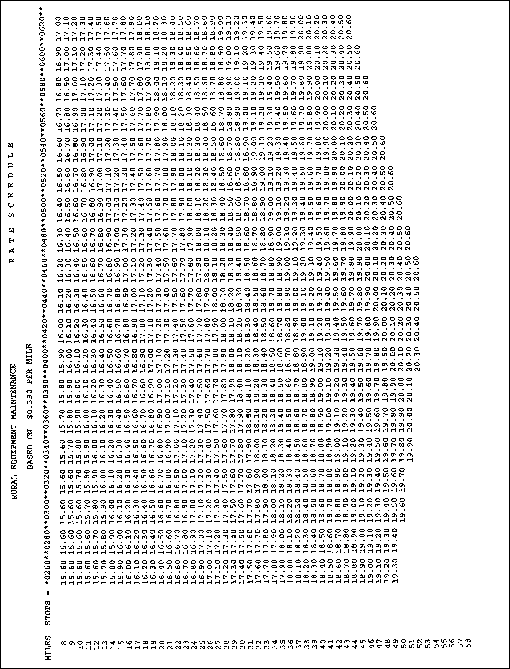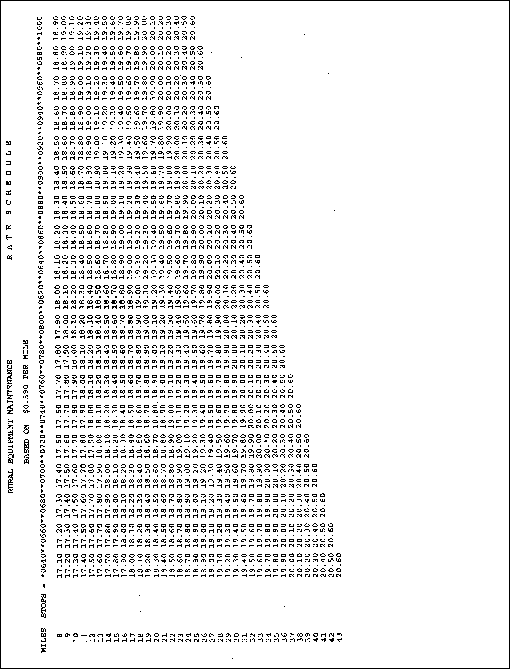|
PUBLICATION 363 REVISION
Effective November 13, 2003, Publication 363, Updating
Address Lists Is a Smart Move, is revised to increase the
maximum permissible number of days from 180 to 185
days for updating delivery address records to meet the
Move Update standard for Presorted and automation rate
First-Class MailŪ pieces. This revision mirrors the revision
to Domestic Mail Manual (DMM) A030.1.1 that was published in Postal Bulletin 22115 (11-13-03, page 34).
Many mailers and address list vendors have requested
this change to increase their flexibility in meeting production schedules and to account for the difference in the number of days in any given cycle of consecutive months. Many
mailers and list vendors prefer to incorporate only two or
four processing cycles into their data processing operations
to cover a complete 12-month period such as a calendar
year or a fiscal year.
With this increase in the number of permissible days for
processing address records before the mailing date, mailers can effectively stay within an even number of processing cycles during any 12-month period. This arrangement
allows mailers to avoid adding another processing cycle
that spills into the next 12-month period, which leads to a
"floating" start date.
We will incorporate these revisions into the next printed
version of Publication 363 and also into the online version
of Publication 363, which is available on the Internet; go to
www.usps.com; click on About USPS & News, then Forms
& Publications, then Browse All Periodicals & Publications,
and then Publications (either PDF Format or Text Format).
It is also available on the Postal Service TM PolicyNet Web
site; go to http://blue.usps.gov; click on More References,
then PUBs.
Publication 363, Updating Address Lists Is a
Smart Move
[Revise the text throughout the publication by changing
each instance of "180 days" to read "185 days."]
- Business Mail Acceptance,
Service and Market Development, 12-25-03
DMM AND POM REVISION
Effective December 25, 2003, the Domestic Mail Manual
(DMM) is revised to clarify that the key fee for additional
keys is nonrefundable. However, the deposit fee for all keys
is refundable. The Postal Operations Manual (POM) is revised to eliminate the limit of two keys for which a customer
can receive a deposit refund. Additional Post OfficeTM box
keys must be listed on PS Form 1094, Request for Post Office Box Key or Lock Service, and customers receive deposit refunds for these keys when returned.
We will incorporate these revisions into the printed
versions of DMM 59 and POM 10 and into the online
updates of the DMM available via Postal Explorer at
http://pe.usps.gov and of the POM available via the Postal
Service TM PolicyNet Web site at http://blue.usps.gov; click
on More References, then Manuals.
Domestic Mail Manual (DMM)
* * * * *
D Deposit, Collection, and Delivery
* * * * *
D900 Other Delivery Services
D910 Post Office Box Service
* * * * *
7.0 KEYS AND LOCKS
* * * * *
7.2 Additional Key Fee
[Revise text to read as follows:]
A box customer may obtain additional or replacement keys
by submitting Form 1094 and paying the refundable key deposit (see 7.1) and the key fee in R900. The key fee for
additional or replacement keys is not refundable. Worn or
broken keys are replaced without charge when returned to
the Post Office where the box is located.
* * * * *
Postal Operations Manual (POM)
* * * * *
8 Special Services
* * * * *
84 Other Delivery Services
841 Post Office Box Service
* * * * *
841.4 Keys
* * * * *
841.46 Refund of Key Fee
[Revise text to read as follows:]
After terminating box service, the Postal Service refunds to
box customers the refundable key deposits for the initial
two keys plus any additional keys listed on PS Form 1094,
if the keys are returned to the Post Office where the box
was issued.
* * * * *
- Customer Service Operations,
Delivery and Retail, 12-25-03
REMINDER
Postal Service TM employees are reminded that the percentage used to tax supplemental wages is different from
the normal taxation percentage(s). As information, supplemental wages include, but are not limited to, prizes,
awards, back-pay awards, severance pay, and reimbursements for moving expenses.
When President Bush signed into law the Jobs and
Growth Tax Relief Reconciliation Act of 2003, one of the
provisions of that law required a change in the percentage
used to tax supplemental wages. Since July 12, 2003, the
percentage used to calculate the taxes due on supplemental wages has been 25 percent. The Postal Service will continue to use the 25 percent tax rate for supplemental wages
until further notice.
- Payroll Accounting,
Finance, 12-25-03
RURAL CARRIERS
In accordance with provisions of Article 9, Section 2.J.3
of the Rural Carrier National Agreement, effective January
10, 2004 (pay period 3-04), the equipment maintenance
allowance (EMA) will decrease from 40.0 cents per mile to
39.0 cents per mile.
The EMA is 39.0 cents per mile, or a minimum of $15.60
per day, whichever is greater.
Employees providing auxiliary assistance or serving
auxiliary routes under provisions of Article 9, Section 2.J.5,
receive an EMA of 39.0 cents per mile or $4.50 per hour,
whichever is greater. This EMA should not exceed the
amount provided in the special EMA for the route stops and
miles.
The EMA rate schedule on pages 4-5 supersedes
all previously published EMA schedules for employees receiving EMA.
- Collective Bargaining and Arbitration,
Labor Relations, 12-25-03


ALL EMPLOYEES
1. Current Mailing Address
To facilitate processing of 2003 tax information and to
ensure correct and timely receipt of a 2003 Form W-2,
Wage and Tax Statement, all employees must have a
current mailing address on file at their local personnel
office. Current employees can use Employee Self Service via the Postal Service TM Intranet or current and former employees may submit PS Form 1216, Employee's
Current Mailing Address, to their local personnel office.
All Form W-2s are sent to the address on file at the time
of printing and will not be forwarded.
2. General Form W-2 Information
If an employee has earnings for more than one state or
locality a separate Form W-2 will be issued for each.
The format of the 2003 Form W-2 has been modified
from the 2002 version as follows:
a. Box 12, "See instructions for box 12," has been expanded to Box 12a and Box 12b.
b. Box 14, "Other (Current Year TSP)," has been renamed "Other."
c. Box 30, "Prior Year TSP Contributions," has been deleted.
See pages 28-29 for an example of the 2003
Form W-2.
3. Inquiries
All inquiries concerning payroll items, such as employee
business expense, equipment maintenance, rent, T-
COLA, money differences between earnings statement
and W-2, leave buy backs, erroneous state or local tax
deductions, Thrift Savings Plan (TSP), Flexible Spending Account (FSA), etc., should be sent to Payroll
Adjustments.
All questions regarding Form W-2s must be submitted in
writing. The request must include:
1. Employee's name.
2. Current mailing address.
3. Social Security number.
4. Name of office where employed (or where previously employed if not a current Postal Service
employee).
5. Year(s) involved.
6. Specific question.
7. Employee's signature.
|
If the first
three digits
of your
Social
Security
number
are...
|
Then submit a written request to...
|
|
000-365
|
ATTN PAYROLL ADJUSTMENTS W 2
EAGAN ACCOUNTING SERVICE
CENTER
2825 LONE OAK PKWY
EAGAN MN 55121-9633
|
|
366 and up
|
ATTN PAYROLL ADJUSTMENTS W 2
EAGAN ACCOUNTING SERVICE
CENTER
2825 LONE OAK PKWY
EAGAN MN 55121-9634
|
The imputed income life insurance amount shown in
Box 35 of the 2003 Form W-2 form is the net result of the
IRS computation for taxable insurance benefits less the
amount an employee pays for optional insurance in the calendar year.
The IRS requires the Postal Service to report as income
the cost of Group Term Life Insurance in excess of $50,000,
which is paid by the employer. The formula is based on an
employee's age, salary, and life insurance coverage.
The following facts will clarify some of the common tax
questions regarding the TSP:
a. Box 12a or 12b, "See instructions for box 12," may
contain employee TSP contributions.
b. TSP contributions are reported in Box 12a or 12b
with a code "D." Letter code "D" is explained on the
reverse side of Form W-2 "Notice to Employee."
c. Box 1, "Wages, tips, other compensation," has been
reduced by the amount of the employee's TSP contributions shown in Box 12a or 12b.
d. Box 16, "State wages, tips, etc.," has been reduced
by the amount of employee TSP contributions in Box
12a or 12b for all states, except New Jersey, Pennsylvania, and Puerto Rico.
(Employees section continues...)
|
